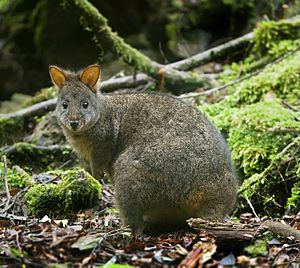Hartz Mountains National Park facts for kids
Quick facts for kids Hartz Mountains National ParkTasmania |
|
|---|---|
|
IUCN Category II (National Park)
|
|

Ladies Tarn, Hartz National Park
|
|
| Nearest town or city | Huonville |
| Established | 1939 |
| Area | 71.4 km2 (27.6 sq mi) |
| Visitation | 11,800 (in 2005) |
| Managing authorities | Tasmania Parks and Wildlife Service |
| Website | Hartz Mountains National Park |
| See also | Protected areas of Tasmania |
The Hartz Mountains National Park is a special place in southern Tasmania, Australia. It's one of 19 National Parks in Tasmania. In 1989, it became part of the amazing Tasmanian Wilderness World Heritage Area. This means it's recognized worldwide for its unique nature and history. The mountains here were named after the Harz mountains in Germany.
Contents
Exploring the Park's Landscape
Most of the park is high up, over 600 meters above the sea. The lowest part is 160 meters near the Picton River. The highest point is Hartz Peak, which is 1,255 meters tall!
Rocks and Landforms
The main type of rock you'll find here is called dolerite. In the southern parts, closer to the ground, you'll see sedimentary rocks. These rocks formed between 355 and 180 million years ago. They were made from sand and mud left behind by oceans, glaciers, and rivers.
Over many years, ice ages have shaped the land. They created cool features like bowl-shaped hollows called cirques. They also made sharp mountain peaks and deep valleys.
Amazing Plants and Animals
The park has many different types of plants. You can find wet eucalypt forests and mixed forests. Some areas have rainforests, and higher up, there are sub-alpine and alpine forests.
Forests and Trees
In the rainforests, you'll see tall trees like myrtle, sassafras, and leatherwood. There's also the native laurel.
The sub-alpine forests have three kinds of eucalypt trees. These include the snow gum and the varnished gum. The varnished gum is Australia's smallest eucalypt! You'll also find yellow gum. Many heath plants grow under these trees, like the beautiful Tasmanian waratah.
Wildlife in the Park
Most of the mammals in the park come out at night. You might spot Bennett's wallabies or Tasmanian pademelons. There are also brushtail possums, echidnas, and platypus.
A special amphibian found here is the moss froglet. It was first discovered in the Hartz Mountains in 1992. Common birds in the park include the eastern spinebill and green rosella. You might also see forest ravens and different kinds of honeyeaters.
A Look at Human History
Long ago, the Mellukerdee Aboriginal people lived in the area of the park. They were the first people to call this land home.
Early European Settlers
In the 1800s, the first Europeans arrived. They were looking for valuable Huon pine timber. In the 1840s, families like the Geeves family settled here. They founded the town of Geeveston. They also created the first walking track to the Hartz Mountains.
Because of this track, the area became a popular spot for bushwalking. People loved to explore the beautiful nature. In 1939, the area was made a "scenic reserve." This helped protect its beauty. Then, in 1951, it officially became a national park. In 1989, it joined the Tasmanian Wilderness World Heritage Area.


